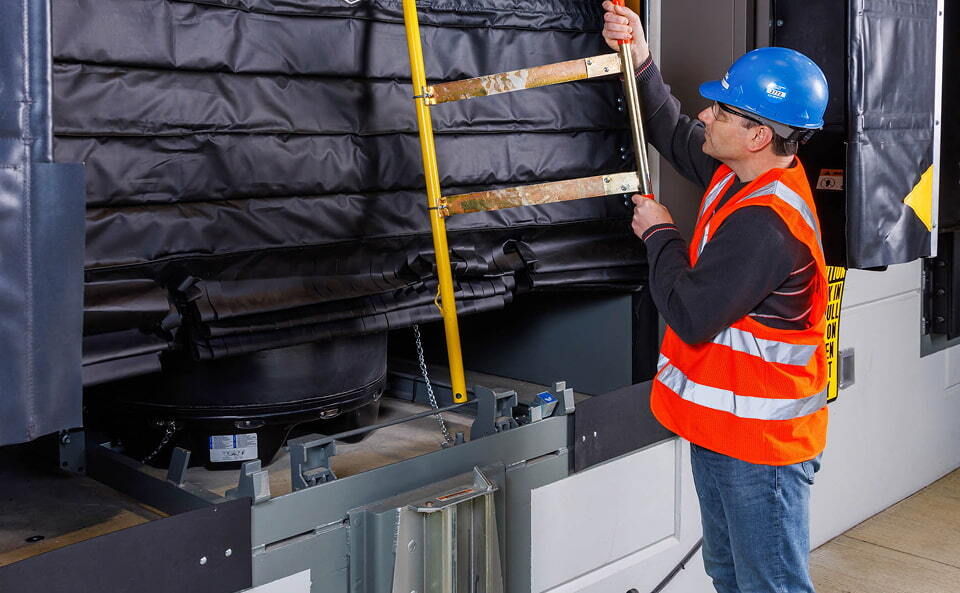Facility managers are under constant pressure to do more with less. Dock equipment is critical to daily operations, yet maintenance budgets rarely keep pace with rising repair costs, labor shortages, and aging infrastructure.
The result? Many facilities fall into reactive cycles, spending more on emergency service calls than planned maintenance.
But there’s a better way. Data-driven maintenance planning transforms dock management from guesswork into strategic decision-making.
By leveraging real-time equipment data, usage trends, and service history, facilities can stretch their budgets further, reduce downtime, and extend the life of critical assets.

The Cost of Reactive Maintenance
Reactive repairs feel unavoidable, but they’re costly. The average emergency dock service call costs $437 per visit, not including parts.
Worse, downtime costs facilities an average of $25,000 per hour, with Fortune 500 companies losing up to 11% of turnover annually to unplanned downtime (Facilities Dive, Evocon).
-
Facilities relying on reactive fixes often:
-
Overspend on emergency labor and parts
-
Struggle with unpredictable costs
-
Replace equipment prematurely due to neglect
-
Increase safety risks and liability
Why Data-Driven Planning Works
Data-driven planning turns maintenance into a proactive investment instead of a reactive expense.
Facilities can:
-
Track actual usage: Identify overworked docks versus underused ones, balancing workloads and avoiding premature failures.
-
Schedule based on utilization: Replace time-based PMs with cycle- or usage-based service, preventing both over-maintenance and missed breakdowns.
-
Connect service history: Centralize logs to spot repeat issues and vendor accountability gaps.
-
Forecast spend: Use data to plan OPEX and CAPEX with confidence, extending budgets further.
Real-World Impact of Predictive Maintenance
Industry research shows the ROI of predictive maintenance is significant:
-
30–40% lower maintenance costs
-
Up to 50% fewer unplanned downtime events
-
20–25% greater equipment availability
-
35–50% reduction in downtime overall (Sumitomo Drive)
And 65% of maintenance professionals report that proactive strategies are the most effective way to cut downtime (Facilities Dive).
How to Stretch Your Maintenance Budget with Data-Driven Planning
-
Audit current costs: Calculate how much is being spent on emergency calls versus planned maintenance.
-
Implement usage-driven alerts: Ensure equipment is serviced based on actual cycles, not arbitrary schedules.
-
Centralize service logs: Eliminate paper-based tracking and move to a digital, asset-specific system.
-
Balance workloads: Use utilization data to spread activity across docks evenly.
-
Align maintenance with CAPEX planning: Use asset health data to delay unnecessary replacements and prioritize high-risk docks.
Preventive Maintenance Checklist for Docks
Use this checklist to reduce breakdowns and extend asset life:
-
Inspect dock levelers for hydraulic leaks, damage, or slow operation.
-
Verify vehicle restraints engage and release properly.
-
Check dock doors for seal integrity and smooth movement.
-
Audit door activation times and ensure sensors are calibrated.
-
Review cycle counts to spot overused equipment.
-
Confirm lighting, signage, and safety barriers are in place and functional.
-
Update digital service logs after each inspection or repair.
👉 Want to see how much you could save with proactive maintenance? Try the ROI Calculator.
The Bottom Line
Maintenance budgets will always feel tight, but reactive repairs waste money, time, and resources.
By shifting to data-driven planning, facilities can predict needs, control costs, extend equipment life, and make smarter budget decisions.
The smartest facilities aren’t the ones spending the most on maintenance, they’re the ones using data to spend wisely.